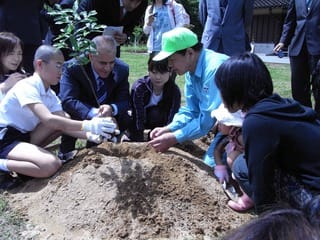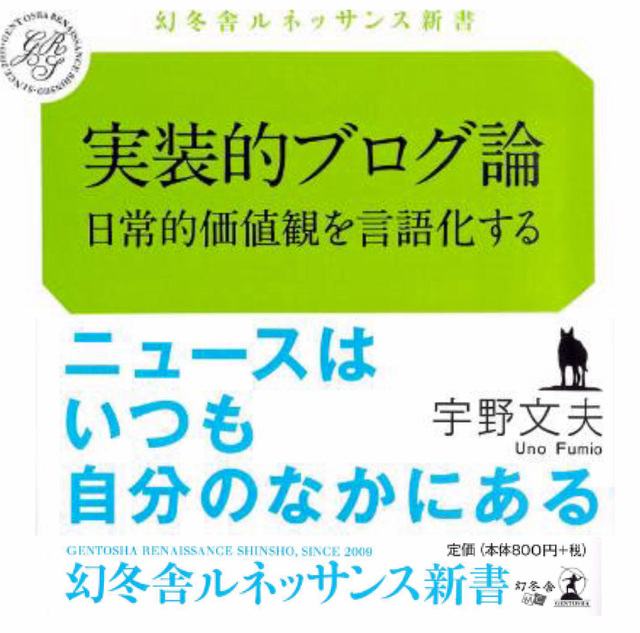 ことしは国際生物多様性年。金沢市で開催された「にほんの里から世界の里へ」と題したシンポジウム(10年2月6日・金沢市)はその幕開けにふさわしいシンポジウムだったと言える。このシンポジウムに生物多様性条約事務局長のアフメド・ジョグラフ氏がビデオ・メッセージを寄せた。(※写真は、金沢大学で学生や子供たちと記念植樹したジョグラフ氏=中央、09年5月23日)
ことしは国際生物多様性年。金沢市で開催された「にほんの里から世界の里へ」と題したシンポジウム(10年2月6日・金沢市)はその幕開けにふさわしいシンポジウムだったと言える。このシンポジウムに生物多様性条約事務局長のアフメド・ジョグラフ氏がビデオ・メッセージを寄せた。(※写真は、金沢大学で学生や子供たちと記念植樹したジョグラフ氏=中央、09年5月23日)
ジョグラフ氏からのメッセージ
Born and raised in Kanazawa, the great Japanese thinker Daisetsu Teitaro Suzuki said that life ought to be lived as a bird flies through the air, or as a fish swims in the water. Suzuki was encouraging us to live as naturally as possible, which, at a different level, is one of the themes of the International Year of Biodiversity in 2010.
金沢に生まれ育った偉大な思想家・鈴木大拙は、「(禅においては)鳥が空を飛び、魚が水に游(およ)ぐように生活されねばならない」と言っています。鈴木大拙は人々に、「できるだけ自然に生きなさい」と奨めているのですが、それは、見方を変えれば、2010年の国際生物多様性年のテーマの一つでもあります。
Over the course of the next several months the 190 parties to the Convention on Biological Diversity will be developing a strategic vision on how humans can live sustainably at the heart of the dynamic ecological system that supports us. A vision of course that the Japanese have long had, in their ancient land management practices of Satoyama. Rural agricultural communities and villages in Japan have a century-old history of carefully managing the forests, grasslands, streams and ponds upon which their living depends. In this time of environmental crisis, the international community has much to learn from such an enlightening culture. I had the immense privilege of visiting Ishikawa Prefecture and I was enlightened by the Satoyama/Satoumi experience.
生物多様性条約の190の締約国は、これからの数カ月間に、豊かな生態系の恵みに依拠して人間が持続的に生きていくためにはどうすればよいか、戦略的ビジョンを練ろうとしています。もちろん日本人は、昔から里山の土地管理方法を通じて、そのビジョンを保持してきました。日本の農村地帯では何世紀にもわたって、人々の生活を支える森、草地、小川、池が、細心の注意で管理されてきました。環境の危機が叫ばれる現代に、国際社会が、このような知恵をもつ文化から学ぶべきことは、数多くあります。以前、石川県を訪問した際には、里山・里海に身を置いて触発されるという、素晴しい経験をさせていただきました。
And this is more important as we all know that the current rate of species extinction has reached an unprecedented rate of extinction. And for some experts may be that the rate of extinction today is one thousand times higher than the natural rate of extinction. And if the current loss rate continues, it is expected that an area of 1.3 billion ha worldwide, about 1.5 times the United States of America, will completely lose its original biodiversity level by 2050.
さて、皆さんもご存知のように、最近の種の絶滅は、前例のない速さで起こっています。自然の状態で起こる種の絶滅の千倍の速さで起こっているのではないか、という専門家もいます。もしこのままの速度で種の絶滅が続くと、2050年までに、世界の13億へクタール、つまりアメリカの1.5倍の広さの範囲で、もともとあった生物多様性が失われると予測されています。
To prevent a worst case scenario, 8 years ago, the parties to the Convention on Biological Diversity set a target: to significantly slow and reduce the rate of loss of biodiversity by 2010. And this was endorsed by the Johannesburg Summit in 2002. Therefore the General Assembly has declared 2010 as the UN General Assembly Year of Biodiversity. This year, also, the third edition of the Global Biodiversity Outlook will be issued in a couple of weeks, which will be based on national reports demonstrating progress in achieving the 2010 target, and, most importantly, shaping the way for the future for the post-2010 target, for the Nagoya 2050 Vision and 2020 target, which will be adopted by the 10th Conference of the Parties in Nagoya, Aichi Prefecture, under the slogan “Live in Harmony into the Future”.
この最悪のシナリオを避けるために、生物多様性条約締約国は、2010年までに生物多様性の損失速度を大幅に減らすという目標を、8年前に設定しました。これは、2002年のヨハネスブルグ・サミットで承認され、国連総会は、2010年を国連の生物多様性年にすることに決定しました。また、今年は、間もなく「世界の生物多様性概況 第3版」が発行される予定です。2010年目標達成に向けた進捗状況の国別リポートを基にする「第3版」は、「地球のいのち、つないでいこう」とのスローガンのもと、愛知県名古屋市で開催される第10回生物多様性条約締約国会議で採択される予定の、2010年以降の目標、名古屋2050ビジョンや2020年目標を設定する上で、非常に重要な意味を持ちます。
As I alluded to earlier, the central element of the new strategic plan will be emphasizing that humans are not outside agents attempting to preserve distant ecosystems, but are deeply dependent on biodiversity for everything that makes life as we know it possible: food, medicine and many other biological goods that sustain both our health and our economic productivity: air purification, crop pollination, and the countless irreplaceable services provided by healthy ecosystems, and the spiritual and cultural fulfillment offered by contact with the natural world.
先ほど触れた新しい戦略プランの核心は、「人間は蚊帳の外から遠くの生態系を守ろうとする存在ではない。人間生活を可能にしているあらゆるものが、生物多様性に深く依拠しているのだ」ということを強調することになるでしょう。すなわち、「食べ物や薬、他のさまざまな自然からの恵みが、健康な暮らしと経済的生産力を支え、健やかな生態系が、きれいな空気、作物の受粉、無数のかけがえのないサービスを提供し、自然界との触れ合いが、深い精神的・文化的な充足感をもたらす」ということを。
The perspective of the so-called Ecosystem Approach received a great boost two years ago in Kobe, in May 2008, when the G8 Ministries of Environment and their partners adopted a Call for Action and put forward Satoyama as a model of how humans should live in and interact with nature. The Kobe Call for Action for Biodiversity agreed to make Satoyama an international initiative, a Japanese-led project to promote Satoyama-like practices worldwide. The initiative gained impetus at the Convention’s 9th meeting of the Conference in Bonn, Germany, and in September 2008 and 2009 when meetings on Satoyama Forum were organized. Your Forum today in Kanazawa is another step towards spreading the wisdom embodied by the Satoyama both more broadly in Japan and throughout the rest of the world.
生態系アプローチと呼ばれる概念は、2年前の2008年5月に神戸で大きく前進しました。この時、G8の環境省や関係団体が、「神戸・生物多様性のための行動の呼びかけ」を採択し、人間と自然の共存モデルとして里山を打ち出しました。「神戸・生物多様性のための行動の呼びかけ」では、里山を国際的なイニシアティブとし、里山的な実践方法を日本が率先して世界に推進していくことを決定しました。このイニシアティブは、ドイツのボンで開催された第9回生物多様性条約締約国会議、ならびに、2008年と2009年の9月に開催された里山フォーラムでさらに勢いを得ました。本日金沢で行われるセミナーは、里山に体現された知恵を、日本のみならず、世界に広めるための大きな一歩となることと思います。
The Director General of the Japanese Ministry of Environment once told me, when I was attending the Satoyama Workshop in 2008, that the Satoyama model can contribute highly towards achieving coexistence between man and nature. I agree with him strongly. Allow me therefore to thank UNU-IAS, the Operating Unit Ishikawa/Kanazawa, and the Research Institute for Humanity and Nature for organizing this important and timely event. And my gratitude, of course, to Anne McDonald, for her fantastic job as the Head of the Operating Unit Ishikawa/Kanazawa. Let me also thank the Forests Culture Association, and its founding organization, the Asahi Shinbun, for collaborating with the Ministry of Environment and the Forestry Agency to strengthen the Green Wave Campaign in Japan. I could have not been more pleased to hear of your plan to have 100,000 planted throughout the Japanese archipelago on May 22, on the occasion of the International Day of Biodiversity, which will be celebrated under the themes “Biodiversity for Development” and “Biodiversity for Poverty Alleviation”. Getting youth to involve in biodiversity conservation is deeply important as they are tomorrow’s policymakers and tomorrow’s citizens, and with the right education and exposure, tomorrow’s champions of the Satoyama International Initiative. I look forward to the Progress Report on the Satoyama Initiative at the 14th meeting of the Convention’s Scientific Body in Nairobi in May, as well as at the COP 10, in Nagoya, Aichi Prefecture.
2008年に開催された里山ワークショップに出席した際、日本の環境大臣は、「里山モデルは人間と自然の共存に大きく貢献できるだろう」と私におっしゃいました。私も強く彼に賛同します。ここで、国連大学高等研究所いしかわ・かなざわオペレーティング・ユニット、総合地球環境学研究所に、この重要で、タイムリーなイベントを主催して下さっていることを感謝申し上げます。国連大学高等研究所いしかわ・かなざわオペレーティング・ユニットのあん・まくどなるど所長には格別の御礼を申し上げたいと思います。さらに、財団法人・森林文化協会とその創設機関の朝日新聞社は、環境省と林野庁と連携し、日本におけるグリーンウェーブを促進して下さっており、心より感謝申し上げます。5月22日は「発展のための生物多様性」、「貧困削減のための生物多様性」というテーマの国際生物多様性の日です。この日に日本列島で、10万本の木を植えようという計画を聞いた時は、この上ない喜びを感じました。生物多様性保全のために、将来の政策立案者であり、将来の市民である若者が参加することは、非常に重要なことです。若者が、きちんとした教育と情報を受ければ、将来、里山イニシアティブを成功に導いてくれることでしょう。5月にナイロビで開催される第14回生物多様性条約締約国学術団体会議、並びに愛知県名古屋市で開催される第10回生物多様性条約締約国会議での、里山に関する進捗状況報告を楽しみにしています。
A practically important moment when the Ecosystem Approach must receive attention is during the UN High-Level Segment of the 65th Session of the General Assembly to be held in September 2010 in New York at the General Assembly, when the High-Level Segment on Biodiversity, with the participation of Heads of States and governments will be convened for the first time ever. We hope that the Prime Minister of Japan will be chairing one of the important meetings on the post-2010 initiative. By keeping Satoyama and the Ecosystem Approach at the heart of our deliberations over the course of the year, we are ultimately ensuring that the theme of integrating humans into nature takes center stage at COP 10 in Nagoya, when an unprecedented range of stakeholders, from youth, to local authorities, to private sector, to scientific communities, to NGOs, to indigenous peoples will gather to shape our post-2010 agenda.
2010年9月にニューヨークで開催される第65回国連総会は、生態系アプローチが注目を集めるべき重要な機会です。この国連総会では、国家元首や首相が参加して、初めて国連の生物多様性首脳会議が開かれます。その時に、生態系アプローチに大きな関心が払われることが期待されています。日本の首相も2010年以降のイニシアティブに関する重要な会議の一つを取り仕切ってくれるでしょう。この1年を通し、里山や生態系アプローチを関心の中心に据えることで、人間を自然と融合させるというテーマが、名古屋でのCOP10の表舞台に出てくると確信します。名古屋でのCOP10には、若者から、地方自治体、民間セクター、科学界、NGO、先住民族などの多様な関係者が集結し、2010年以降の論点を整理してくれることと思います。
“Follow nature and return to nature” advises the celebrated Japanese poet Matsuo Basho. I am sure that we will see this wisdom on display in 10 months’ time, when Kanazawa hosts the closing ceremony of the International Year of Biodiversity in December 2010, and the launch of the International Year of Forests in 2011. I look forward to celebrating with you on that important occasion and hope we will all keep the slogan of the IYB in mind far beyond 2010.
偉大なる日本の俳人・松尾芭蕉は、「自然に従い、自然に帰れ」と言っています。2010年12月に金沢が国際生物多様性年のクロージング・セレモニーを主催し、2011年の国際森林年のスタートが切られるまでの10カ月にわたって、この知恵が発揮され続けるでしょう。このように重要な出来事を、皆さんと祝うことが楽しみです。また、皆さんが、国際生物多様性年の「地球のいのち、つないでいこう」とのスローガンを、2010年以降もずっと覚えて下さることを望んでいます。
Biodiversity is indeed life, and biodiversity is our life.
生物多様性とは、まさしく我々の命そのものなのです。
⇒7日(日)夜・金沢の天気 くもり















